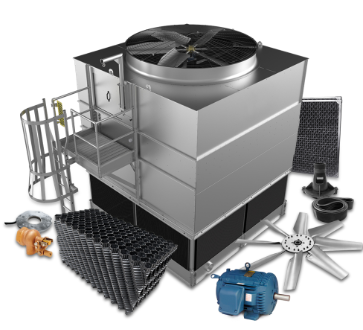Sep. 14, 2023
Machinery
Venturing into the realm of cooling tower parts is a captivating odyssey through the annals of time and technological advancement. In this comprehensive article, we embark on a journey to unravel the intricate workings of cooling tower elements, tracing their historical lineage and uncovering their multifaceted roles.
The origins of cooling towers can be traced back to the 19th century, coinciding with the advent of the Industrial Revolution. These ingenious devices initially emerged in tandem with steam engines, serving a singular purpose: cooling these mighty mechanical engines. This marked the inception of cooling tower technology, a field that would only grow in significance as time marched forward.
Condensers, referred to as "condensers" in Persian, represent indispensable fluid coolants, predominantly harnessed in power plants. These pivotal components of cooling tower parts often assume the form of colossal vanes, akin to industrial-scale fans. Notably, condensers are not confined to power plants alone; refineries and corporate edifices also rely on them to maintain optimal temperatures within their sprawling industrial spaces.

A question that often arises pertains to the scalability of cooling towers. Are they exclusively designed for mammoth factories and sprawling refineries? Surprisingly, these versatile contrivances can adapt seamlessly to a myriad of sizes and applications. Cooling towers can be tailored to suit the unique demands of diverse scenarios, whether on a grand scale or in more modest dimensions.
At its core, a cooling tower functions as a heat exchanger. Its constituent parts operate in harmony to regulate ambient temperatures by managing the influx of boiling water from diverse sources. This intricate process involves transferring heat from industrial devices to the cooling towers, which subsequently lower the water's temperature before channeling it back into the operational cycle of these devices.
Like the intricate cogs of a well-oiled machine, cooling towers comprise a plethora of components, each entrusted with a distinct role. Let's embark on an exploration of these crucial elements:
Sitting atop the cooling tower, the cap element plays a pivotal role in upholding the tower's structural integrity. It serves as a barrier, preventing the escape of steam and water droplets, a crucial function in preserving valuable resources and averting potential safety hazards.
A conical marvel nestled within the tower, the dispenser ensures the uniform distribution of heated water. As water descends through this device, it not only enhances cooling efficiency but also guarantees that all cooling points receive a copious supply of water.
The fan motor assumes a pivotal role in the safety apparatus of the cooling tower. It acts as a vigilant sentinel, protecting against potential explosions and ensuring the seamless operation of the device, even when confronted with dynamic internal processes.
Drawing inspiration from the intricate honeycomb cells of nature, cooling tower fillers facilitate the cooling process. Boiling water courses through these fillers, shedding heat as it mingles with the air inside the tower. Two prevalent types of fillers include membrane fillers and sprinkler fillers.
Much like a vigilant doorman, the mesh serves as a protective shield, thwarting the ingress of unwelcome guests, such as rodents, into the tower. Its role extends beyond mere security—it safeguards the tower's hygiene and integrity by permitting only water to enter.
Positioned at the entrance of the cooling tower reservoir, the air valve stands as the vanguard against detrimental chemical interactions within the tower. Its presence ensures water clarity and the absence of sulfates, ultimately prolonging the tower's lifespan.
The most conspicuous aspect of the cooling tower is its body and building, typically crafted from Fiber-Reinforced Plastic (FRP). This protective shell envelops and encapsulates all the intricate activities transpiring within the tower, offering a safeguard for its indispensable functions.
The configuration of a cooling tower is subject to considerable variation, contingent upon its intended purpose and performance demands. These towers exhibit a diverse array of shapes and sizes, ranging from cone-shaped structures spanning diameters of 200 to 100 meters to rectangular counterparts with dimensions expanding to 40 to 80 times their width.
In summary, comprehending the intricacies of cooling tower components unveils a captivating journey into the heart of technological innovation. These remarkable devices have traversed a path from humble beginnings alongside steam engines to their pivotal roles in contemporary industrial processes. Whether found in power plants, refineries, or corporate complexes, cooling towers continue to shape and sustain our world, ensuring its efficient operation.
Previous: What is BOP control system?
If you are interested in sending in a Guest Blogger Submission,welcome to write for us!
All Comments ( 0 )